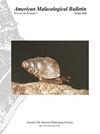Digital Three-Dimensional Imaging Techniques Provide New Analytical Pathways for Malacological Research
IF 0.4
4区 生物学
Q4 MARINE & FRESHWATER BIOLOGY
引用次数: 36
Abstract
Abstract: Research on molluscan specimens is increasingly being carried out using high-throughput molecular techniques. Due to their efficiency, these technologies have effectively resulted in a strong bias towards genotypic analyses. Therefore, the future large-scale correlation of such data with the phenotype will require a significant increase in the output of morphological studies. Three-dimensional (3D) scanning techniques such as magnetic resonance imaging (MRI) or computed tomography (CT) can achieve this goal as they permit rapidly obtaining digital data non-destructively or even entirely non-invasively from living, fixed, and fossil samples. With a large number of species and a relatively complex morphology, the Mollusca would profit from a more widespread application of digital 3D imaging techniques. In order to provide an overview of the capacity of various MRI and CT techniques to visualize internal and external structures of molluscs, more than twenty specimens ranging in size from a few millimeters to well over one meter were scanned in vivo as well as ex vivo. The results show that all major molluscan organ systems can be successfully visualized using both MRI and CT. The choice of a suitable imaging technique depends primarily on the specimen's life condition, its size, the required resolution, and possible invasiveness of the approach. Apart from visual examples derived from more than two dozen scans, the present article provides guidelines and best practices for digital 3D imaging of a broad range of molluscan taxa. Furthermore, a comprehensive overview of studies that previously have employed MRI or CT techniques in malacological research is given.数字三维成像技术为线虫学研究提供了新的分析途径
摘要:高通量分子技术越来越多地应用于软体动物标本的研究。由于它们的效率,这些技术有效地导致了对基因型分析的强烈偏见。因此,未来此类数据与表型的大规模相关性将需要显著增加形态学研究的产出。三维(3D)扫描技术,如磁共振成像(MRI)或计算机断层扫描(CT)可以实现这一目标,因为它们允许从活体、固定和化石样本中快速获得非破坏性甚至完全非侵入性的数字数据。软体动物种类众多,形态相对复杂,因此数字3D成像技术的广泛应用将使软体动物受益。为了提供各种MRI和CT技术可视化软体动物内部和外部结构的能力的概述,从几毫米到一米多不等的20多个标本在体内和离体扫描。结果表明,所有主要的软体动物器官系统都可以通过MRI和CT成功地可视化。选择合适的成像技术主要取决于标本的生存条件、大小、所需的分辨率和可能的侵入性。除了来自二十多个扫描的视觉示例外,本文还提供了广泛的软体动物分类群的数字3D成像指南和最佳实践。此外,全面概述了以前在线虫学研究中使用MRI或CT技术的研究。
本文章由计算机程序翻译,如有差异,请以英文原文为准。
求助全文
约1分钟内获得全文
求助全文
来源期刊
CiteScore
1.00
自引率
40.00%
发文量
1
审稿时长
>12 weeks
期刊介绍:
The American Malacological Bulletin serves as an outlet for reporting notable contributions in malacological research. Manuscripts concerning any aspect of original, unpublished research,important short reports, and detailed reviews dealing with molluscs will be considered for publication. Recent issues have included AMS symposia, independent papers, research notes,and book reviews. All published research articles in this journal have undergone rigorous peer review, based on initial editor screening and anonymous reviewing by independent expertreferees. AMS symposium papers have undergone peer review by symposium organizer, symposium participants, and independent referees.

 求助内容:
求助内容: 应助结果提醒方式:
应助结果提醒方式:


